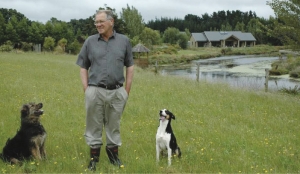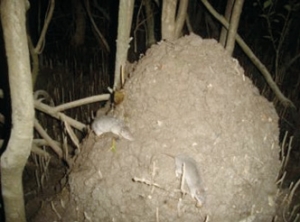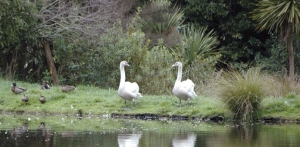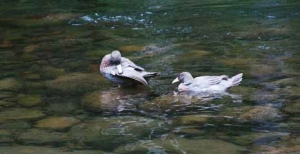Displaying items by tag: Habitat
Fish deaths call for relocation project rethink
When more than 900 brown mudfish in the Wairarapa were transferred to a new wetlands habitat to make way for wastewater storage reservoirs, the district council initially claimed it was a success, but it was later learnt that most of the fish did not survive.
Fish & Game reported that the project in December and January involving 921 mudfish, organised by Carterton District Council, had resulted in virtually none surviving.
In July Greater Wellington Regional Council told the Wairarapa Times-Age that it would undertake further monitoring of the translocated population and would be tracking how the mudfish and their habitat were doing.
“Our immediate focus is on creating additional habitat that we believe will be more suitable for brown mudfish,” it said. “Once we are happy that this new habitat is established, we will relocate the remaining mudfish.”
GWRC believed mudfish were still present in the wetland where they were relocated, but in lower numbers.
“Unfortunately, the habitat created did not develop as we had hoped, in particular in relation to the aquatic vegetation cover that would have provided cover for the mudfish.
“High water temperatures and predation by birds, such as shags and herons, are considered to be among some of the key issues that impacted on the success of the translocation.”
GWRC will continue to work closely with the district council to create a new habitat more similar to the original area the fish were relocated from.
“We will be incorporating the learnings so far to ensure that the project has the best chance of success, in terms of maintaining and enhancing brown mudfish habitat.”
The project will now be led by Alton Perrie, an environmental scientist from GWRC who has “considerable expertise in mudfish”.
Fish & Game Wellington manager Phil Teal has called for an independent inquiry by the Department of Conservation into the transfer.
A Fish & Game senior scientist even advised the project co-ordinators last year that this project was not advisable.
“This is $160,000 of ratepayers’ money that would be much better used on meaningful conservation projects that would benefit all fish habitat,” he said.
Operation Duck Pond
With about 90 percent of New Zealand’s wetland lost over the past 150 years, Fish & Game NZ realises there’s a compelling need to assess the role that ponds play in successfully managing waterfowl.
Ponds have been established across the New Zealand landscape for various purposes including stock watering, irrigation, storm water capture, effluent ponding, waterfowl habitat and simple aesthetic values. Currently, there’s little scientific information on what, and how big a role these ponds play as habitat for waterfowl populations.
The aim of this ‘citizen science’ project is to determine what pond habitat features provide good breeding for waterfowl, and promote good pond management practices for breeding these birds. Fish & Game has launched an appeal for people who want to monitor waterfowl populations on ponds around their area. The aim is to establish a network of ponds to be closely monitored over the breeding season.
You don’t have to be a scientist! All volunteers will be given a set of simple instructions on how to go about monitoring. Fish & Game will supply a manual with simple instructions on how to run their surveys – so everyone round the country is tackling the project the same way, and volunteers gather the best data possible.
If you’re keen to help with collection of data and are prepared to monitor a pond, a fun and fulfilling project that will help New Zealand’s waterfowl and other native water dependant birds, this project is for you. Don’t forget – we are keen to hear from a wide range of people, including youngsters. Kids – depending on your age, you may need to line up support from mum and dad, a friend or relation.
Your help in this project will not only provide data to drive management decisions, but will give waterfowl enthusiasts, hunters and landowners a unique opportunity to get involved and make a real hands on contribution to our efforts to manage waterfowl – and keep their numbers up!
Change attitudes and improve the environment
Change attitudes and improve the environment
Into this area a few years ago stepped Ducks Unlimited member Ossie Latham, and his conscious was pricked by the degradation he saw in the waterways near his home.
Growing up on the banks of the Oroua River downstream from Feilding, part of a third generation on both maternal and paternal sides of his family he remembers: “During that time the Oroua had gone from a pristine small river where kids could swim in deep holes, dive off the road bridge, catch eel, trout and flounder, to a gravel choked conduit for industrial, town and farm waste. A dead waterway, the greatest degradation happened in my time as a kid,” said Ossie.
Then came concern for the Manawatu River and its’ tributaries of which the Oroua is one. The Manawatu River Accord was set up and out of that spun the Oroua Catchment Care Group. Ossie attended their meetings and the Oroua Group decided the best way to tackle the problems was to think catchment wide
but act local to address whatever issues may be in any given area. The Mangaone West stream where Ossie and wife Mary live is a tributary of the Oroua. Ossie volunteered to be champion for that area.
As a local champion his job was to gage the support of residents for a collective effort to address issues of farming and lifestyle practises that degrade the environment.
“Once sufficient interest was identified, we called a community meeting and established the Mangaone West Landcare Group.
Neil Managh, coordinator of the original group gave his support to Ossie who
then called on the leading farmers in the area, the local school principal, known
environmentalists, friends and acquaintances and got their commitment to the scheme.
“We organised a community wide pamphlet drop calling a public meeting and away we went,” Ossie said.
whatever we do to our landscape sooner or later affects our wetlands and waterways, I think it is worth DU members thinking about what happens upstream from their favourite dam, wetland or waterway.
About 60 percent of landowners are part of the group. All major farmers bar two are committed and interest is growing. There is a diversity of views on what best practise is and just what is sustainable but Ossie said they cope with this by agreeing that “Sustainability is the ability of the current generation to meet its needs, without compromising the ability of future generations to meet theirs.”
“I’m not sure where I got the quote from but it gained widespread acceptance to what we are on about.
“We recognise it’s taken over 100 years to get where we are now, so we expect our work to improve our chosen living spaces to be intergenerational. While the stream is our common bond, we love our landscape which the stream and we are part off.”
(Afterthought)
“After doing the question and answer bit for you I got to thinking, what is the key for many of the settler families who are part of our group? Many of them are 3rd and 4th generation; they have a strong sense of stewardship, a concept that is evolving as our knowledge of interdependence grows. It’s good to be part of their efforts.”
Joining the dots on Watermouse
With support of several organisations, Janina Kaluza has been surveying, monitoring and researching the water mouse in a number of locations throughout the Wide Bay and South East Queensland region since February 2012. This work has expanded and built on previous research in the past 15 to 20 years by scientists within State Government and the broader community. However, gaps remain on information that Janina aims to fill.
The water mouse inhabits coastal areas of central and south east Queensland, Northern Territory and New Guinea, and is typically found in coastal saltmarsh and mangrove areas. A key sign of their presence is their nesting mounds that range from free-standing mounds in saltwater couch grasslands to sheltered mounds in sites such as the base of old grey mangrove trees (Avicennia marina) located within the intertidal zone. The water mouse forages in the mangroves at night, feasting on invertebrates such as crabs, shellfish and snails. Loss, fragmentation and degradation of their habitats are key threats to their survival.
Working with local councils, WetlandCare Australia has been awarded funding to undertake a number of small local projects to survey potential water mice habitat areas. The combined information from these projects will contribute towards completing the jigsaw puzzle on water mice in south east Queensland.
Another project focuses on surveying key habitat areas on Russell Island, one of the Southern Moreton Bay Islands, with funding support from a Redland City Council’s Conservation Grant. The water mouse was recorded on the island in the 1990s. The project aims to determine if the water mouse is still present and identify current threats to its habitat and survival. Surveys undertaken over three days in May this year and the data and survey results are currently being collated.
Funding through the City of Gold Coast’s Community Grants Program, WetlandCare Australia will be focussing water mouse survey effort in the Jacobs Well area in early 2016. Survey work will build on knowledge obtained in the 1990s that recorded the presence of the water mouse in this area. Logan City Council, through their Enviro Grants allows for surveying potential habitat areas on the Logan River in search of the water mouse. Approximately 40ha of mangrove areas will be surveyed in early 2016 to record the presence or absence of nests.
Water mice surveys will also be undertaken in early 2016 over 80ha of mangrove vegetation near the mouth of the Caboolture River with funding through the Moreton Bay Regional Council’s Community Grants Program. This project aims to identify the presence or absence of the water mouse in this area. The water mouse has been recorded previously at nearby Donnybrook.
Mute swans on site
Having their own water feature right in front of their home is a rewarding and entertaining result for hard work for Steve Clarkson and Lyn Watson.
Several years ago they built their attractive home that sits right on the edge of their main pond, and now after years of toil they have a grand vista as a backdrop to their everyday living.
Just last year they acquired two Mute Swans. The pair settled in well, and add another interesting touch to the scenery. With luck there will be more than two white swans on that pond.
Steve and Lyn also run a few black and coloured sheep and Lyn takes full advantage of using their wonderful wool to make a variety of garments and useful items.
Crayfish (Koura) anyone
When I was a kid (and that was a while ago), there was a stream a couple of gullies away from our place with freshwater crays (koura) living there. They were not big but they did taste good.
On a camping holiday at Taupo there was the opportunity to head off to the lake outlet and dangle tempting tit bits on string and pull up a few koura, and they were slightly bigger than the ones at home.
So it was with interest that recently I read about a South Island forestry company who decided to stock their fire-fighting ponds with fresh water crayfish. What a smart idea. They now have 400 ponds.
Takes a while for the little koura to get big enough to provide a good meal, and I don’t know how they would co-habit with ducks, but for those with a good sized pond/lake it just might be a new idea.
It seems their distribution is shrinking through loss of habitat. So this could be an interesting venture or hobby it you have the right sized water area. The Department of Conservation regard them as a threatened species, so if you lean more toward conservation than a good meal, this could be an opportunity to do a bit for their survival.
Koura may possibly prefer free flowing water so a quiet pond might not be their home of choice.
But don’t be in a rush to eat them – it takes a while for them to reach eatable size. Feeding them might help. Oh - and you do need a permit if you consider farming them as a commercial venture.
Liz Brook
Duck broods under constant threat from predators
Southland has long been recognised for its duck population and the associated buzz around the district during the first weekend in May!
However, the combination of several poor mallard breeding seasons in a row and in response to hunters concerns about the struggling North Island population, the Southland Fish and Game Council funded a national mallard research project. I was fortunate to have my Master’s research funded as part of this wider project.
The Southland Council had expressed concern about continual dairy conversions and the associated changes in pasture management that might affect duckling survival. Consequently, for my research I focused on female habitat selection and factors that may impact duckling survival.
In terms of pasture management, I found that duckling survival is comparable between dairy and sheep/deer pastoral grazing systems. This is good news for mallards in Southland, as we readily see our landscape convert to dairying systems. However, first and foremost, broodrearing females in Southland are selecting for ‘unmanaged habitat’ i.e., everything that is not pasture (hedgerows, shelterbelts, rank grass). This may not seem like an unexpected result, but alarmingly, these types of habitat are associated with lower duckling survival.
In our landscape, these habitats are typically thin and linear in configuration, creating ideal travelling corridors for predators. While broods may feel safe and protected tucked up in a hedgerow, predators that rely on their olfactory sensory system to track prey can easily run along the downwind side of these strips and pick up the scent of a sitting duck.
Additionally, I found that duckling survival is reduced for broods that spend their time closer to houses and roads, with both being structures that tend to be associated with a higher predator presence. Over the two year study period, 15-25 percent of our breeding females were killed on the nest by predators. To put this figure in context, this is similar to the proportion that we, as hunters, shoot each year. Further, an additional 30 percent of nests last season were abandoned or destroyed due to predators. At necropsy (post mortem examination), many of these females had evidence suggesting both mustelids and cats were the main perpetrators. While more research is needed, these results suggest that predators are having a much bigger impact on our mallard population than we originally suspected. Luckily, predator abundance is a factor that we can all influence. Further, in reducing the predator guild, you may be surprised in what other wildlife you attract!
Operation duck pond
After chasing ducks through the 2014 breeding season, staff noticed definite differences in ponds that were used by ducks and broods. Consequently, over the 2015 breeding season, we deployed 21 game cameras on ponds throughout the region that captured images every five minutes during daylight hours. If you do the math, that means I have roughly 250,000+ photos to wade through! As a result, I have not quite made it through all these photos to run the analysis. However, I can make a few comments on factors that seem to have an impact on the ponds I have made it through thus far.
Typically, the shallower ponds with plenty of feeding bottom (at least 43cm deep) have had hundreds of headless, ‘bums-up’ photos. Another example is a pond that only has water in it during the breeding season. These seasonal bodies of water tend to be the most productive in terms of invertebrate presence, and this may flow through into brood use. In last year’s study, I found that the presence of ephemeral water (short-lived bodies of water) during the first 10 days of a ducklings life, had a huge impact on survival. For Southland, cumulative duckling survival to 30 days of age without ephemeral (lasting only a short time), water present was only 11 percent for broods raised by yearling females compared to 26 percent for broods raised by adult females. However, with the presence of ephemeral water, duckling survival dramatically increased to 28 percent for broods raised by yearling females and 46 percent for broods raised by adult females. Initially, ducklings require a high protein food source, which is readily available in ephemeral water, particularly in the form of earthworms that are forced to the surface. Hence, this may be why Southland is recognised as a duck factory, and as duck enthusiasts, we shouldn’t be complaining about the weather! Consequently, management of pond water levels to mimic a seasonal body of water might be one way to encourage duck use of ponds.
Another observation that might be important to brood use is the degree of exposure of the pond to the elements. The more barren-like ponds lacking any edge, bank, or overhead cover tend to have very limited use by any mallards, and none by broods. It will be interesting to see what factors come out of the data, but my gut feeling is pond use by broods is a combination of factors that create a sheltered, food-laden haven…. Watch this space! After chasing ducks through the 2014 breeding season, staff noticed definite differences in ponds that were used by ducks
Erin Garrick
DU Flight NZ Game Bird Habitat Trust
The NZ Game Bird Habitat Stamp programme and the Game Bird Habitat Trust Board play an important role in the protection, enhancement and creation of game bird habitat in New Zealand. While the major focus has been on wetlands, upland game bird habitat is also included. In addition, any improvement of wetlands is also of benefit to a wide range of other wetland birds and fish.
The NZ programme was initiated in 1993 and was based on the programmes operating in Canada and the USA. DUNZ actively supported its establishment. The programme is ably administered by Fish and Game NZ who process the funding applications and provide the secretarial support for the Trust Board.
Board Members
Board members are appointed by the Minister of Conservation on the recommendation of Fish and Game (4 members), Ducks Unlimited (1 member) and a member nominated by the Director General of Conservation.
Current members are:
Andy Tannock – Chairperson (Manawatu), Ian Hogarth (Canterbury, formerly Northland), Mark Sutton (Southland), Steve Cragg (Gisborne), John Cheyne, DU representative (Hawke’s Bay), Susan King, DOC nominee (Malborough).
Functions
The functions of the Trust Board are set out in Section 44D of the Wildlife Act 1953. The Board’s primary focus is applying funds obtained from the Habitat Stamp programme as grants to applicants for the protection, restoration, improvement, creation, or procurement of game bird habitat.
The Board can also:
- Identify and evaluate areas for protection or restoration of habitat
- Negotiate with landowners and other agencies for the protection and restoration of habitat
- Promote or provide advice on protection and restoration of habitat
- Promote the sale of game bird habitat stamps and associated products
- Recommend the game bird or other wildlife species to be depicted on stamp.

_2017_Game_Bird_stamp.png) NZ Game Bird Trust Stamp
NZ Game Bird Trust Stamp
Funding
Funding for the Trust comes from the $3 Game Bird Habitat Stamp, recently increased from $2, from every game bird hunting licence and a proportion of the external sale of stamps to collectors and prints of the annual bird painting. The money raised each year from game bird habitat stamps is transferred from Fish and Game Councils to the Game Bird Habitat Trust. Currently this is approximately $100,000.
Major Projects
The Trust Board is working with wider community interests in implementing a wetland management plan involving a small number of large projects in both the North and South Island. This has included the Para Wetland near Blenheim and Taikitakitoa Wetland near Dunedin
It is currently considering how to help with the JK Donald Block on the north-eastern edge of Lake Wairarapa and the Underwood Wetland near Dargaville. These projects are ranked highly by the Habitat Trust Board for development of a sponsorship package on the basis of game bird and other wildlife habitat enhancement potential.
DU received significant financial assistance from the Trust in developing the Wairio wetland.
Annual Grants
Applications for grants from the Trust close on 30 June each year and are open to anyone with support from the landowner and a recognised habitat referee. Information and forms are available from the Fish and Game NZ website.
This year (2017) the Trust has received 30 applications and these will be considered by the Board when they meet in the Wairarapa 24-25 August. They will also be visiting Wairio wetland during their visit.
Supplied by John Cheyne.





